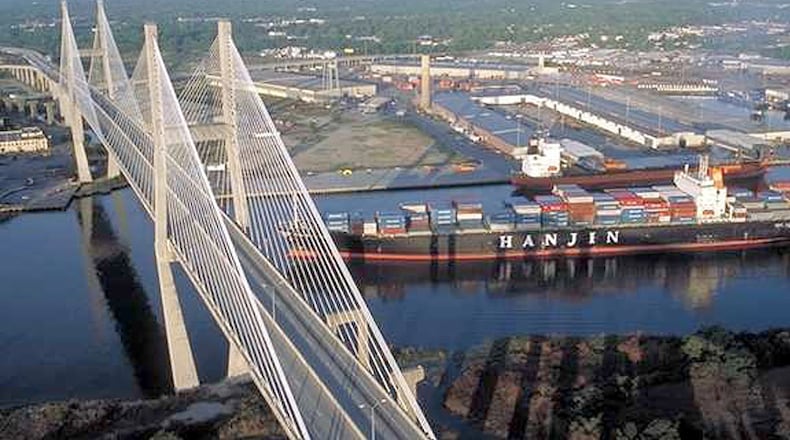SAVANNAH ― State transportation officials say they will need about a decade to replace the Talmadge Bridge, the iconic cable-stayed span on the edge of Savannah’s historic district.
At a meeting Thursday of the State Transportation Board, Georgia Department of Transportation officials said they will recommend a path for a new river crossing in fall 2025. From there, they will secure permits and funding for the project ahead of building the replacement, likely either a new, higher bridge or a tunnel under the river. Construction will take an additional nine to 11 years.
“A journey of a thousand miles starts with a single step, and we’re taking a couple of steps here,” GDOT Commissioner Russell McMurry told board members. “When it’s time, we’re not starting at zero, we’re already on the path.”
McMurry’s comments came following a presentation on what GDOT has dubbed the Savannah River Crossing project. The state agency has been studying and planning the replacement since Georgia Ports Authority CEO Griff Lynch called for the Talmadge Bridge’s removal in 2018. Lynch voiced concerns about the ability of next-generation cargo ships to access port terminals located upriver from the span’s height.
The authority operates the third-busiest port in the United States and currently has two cargo container terminals — with a third under construction — on the upriver side of the span, meaning ships must pass beneath the bridge when arriving and departing the port. Ports Authority facilities support 561,000 jobs and contribute $59 billion annually to the state’s gross domestic product, according to a study by the University of Georgia.
The process to replace the bridge started with a feasibility study that explored 27 replacement options. The report went public in December and received broad attention, particularly for the price tags of its recommendations: $1.17 billion for a new, 230-foot-high bridge and $2 billion a two-tube tunnel.
GDOT introduced the project to federal transportation officials in March and Savannah leaders in April. A public comment period began earlier this month and stretches through June 6, with an open house scheduled for 6 p.m. Monday at the Coastal Georgia Center in Savannah.
Public engagement will continue through the summer and fall, with GDOT officials meeting with neighborhood associations, environmental groups and other stakeholders. Project manager Chandra Brown said GDOT will use those responses to narrow the focus to a “single preferred alternative” and solicit public feedback on that option in fall 2025.
Engagement with city residents and businesses is vital given the potential for long-term disruptions caused by the project, Savannah Mayor Van Johnson said. Construction would affect densely populated areas, including the west end of the busy riverfront and nearby residential neighborhoods.
“Savannah is greatly affected no matter when they do it because there’s not a lot of landing space for a bridge or where they want to go underground with a tunnel,” he said. “I hope that more-than-adequate time and attention are attributed to addressing the potential impacts and that GDOT will work with the city to minimize those impacts.”
During Thursday’s committee meeting, McMurry said the state needs to move ahead with the bridge replacement. He noted that one of the largest cargo ships currently calling on East Coast ports, the Marco Polo, has visited Savannah twice in the past year and barely cleared the bridge.
On one of those sailings, the vessel’s communications antennas brushed the bridge’s underside, McMurry said. The Talmadge’s roadway stands 185 feet above the water at high tide.
Ships significantly larger than the Marco Polo — with superstructures reaching 220 feet above the waterline — have entered service in recent years.
The update on the Talmadge Bridge replacement plan comes as a maintenance project to elevate the existing span is just beginning. A contractor, Peachtree City-based Kiewit Infrastructure South, is readying to replace the bridge’s cables, which are nearing the end of their life span, with shorter supports that could provide an additional 20 feet of clearance.
The cable replacement is to begin in early 2025 and is expected to be completed in 2028.
About the Author
Keep Reading
The Latest
Featured


